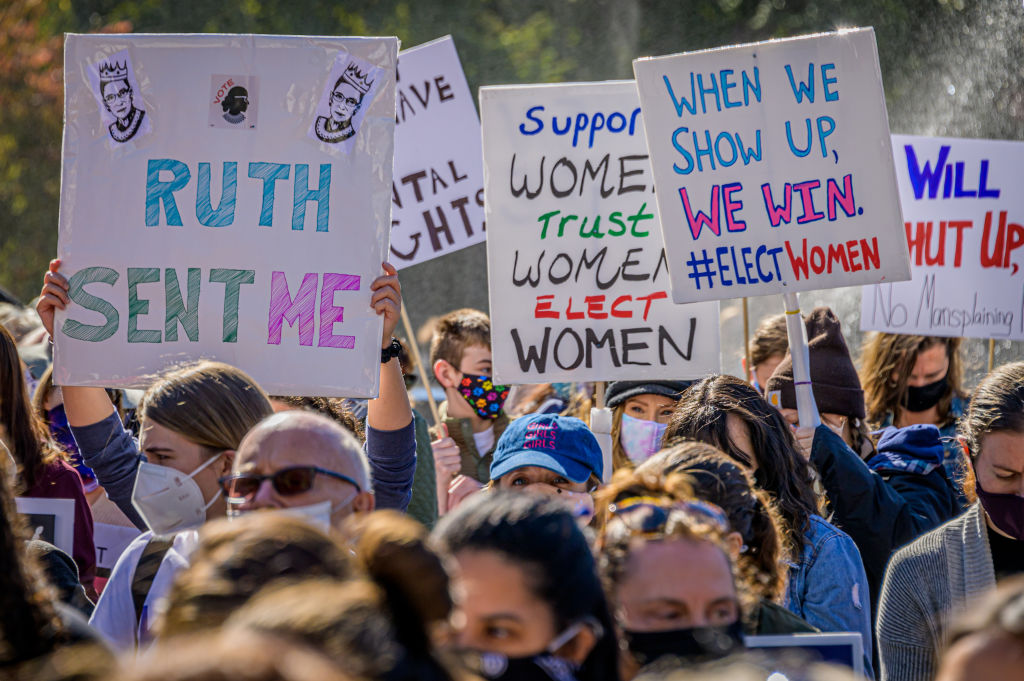Despite a recent surge of women candidates, women are still very unlikely to run for office. If the status quo is to change, the strategy for building a pipeline of women willing to run must change.

Despite the efforts of dozens of organizations and investment of millions of donor dollars over decades poured into convincing more women to run for political office, the newest report from Jennifer Lawless and Richard Fox’s Citizen Political Ambition Study finds that the political ambition gap between men and women interested in running for office is virtually unchanged in the 20 years since the study was first conducted. The pipeline of women interested in running for office remains broken. If there is to be further progress in closing the remaining gender gap in political leadership, something must change.
Despite the much lauded years of the woman in 2018 and 2020, representation of women in elected office in the U.S. remains low. Women still make up less than a quarter of the U.S. Senate, and less than a third of the House of Representatives. Women make up just under a third of all state legislators, and there are still only nine women governors.
The recent surge of female candidates gives the misleading impression that significant change is afoot. According to the Center for American Women and Politics (CAWP) at Rutgers University, 643 women filed to run for Congress in 2020 (60 for the Senate, 583 for the House)—a record-breaking number. The problem is that record breaking is still under 30 percent of all the major party candidates for the House and less than a quarter of the candidates for the Senate. To close the gender gap in elected office, 30 percent is not nearly enough.
The fact is, women are still very unlikely to run or consider running. The percentage of women who considered running for office actually declined from 2011 to 2021, according to Fox and Lawless, despite the rise of high-profile women on both sides of the aisle in elected office. For years activists theorized that more female role models in elected office would make a difference. Apparently not.
There are many reasons women candidates turn out in smaller numbers; women often critique their own credentials and qualifications and count themselves out. There’s a lack of encouragement from other elected officials and activists, and public messaging. And, clearly the proliferation of sexist attacks against women candidates both on the campaign trail and once in office has been a factor in keeping women on the sidelines. And young women who have documented most of their lives in photos, videos and on social media, may look at the example of former Rep. Katie Hill—who had nude photos of her posted in the tabloids without her consent—and the way old posts are used to attack women in the public eye, and decide it just isn’t worth it.
The percentage of women who considered running for office actually declined from 2011 to 2021, despite the rise of high-profile women on both sides of the aisle in elected office.
Rising political pessimism is also a concern. In the Fall 2021 Harvard Youth Poll, a third of young men and a third of young women said they were less politically engaged than their parents, and the same percentage considered themselves politically engaged or active. Millennials and Gen Z were more concerned about the economy and their ability to pay their bills and housing than the population overall. AIT’s September 2021 poll found that only 35 percent of 18- to 29-year-olds were very motivated to turnout in 2022. A YWCA survey found only 21 percent of Gen Zers are motivated to vote in 2022, despite a majority of them feeling that the election will impact their lives.
Fundamentally, if the status quo is to change, the strategy for building a pipeline of women willing to run must change, and showing a path to positive engagement is essential. In the seven years All In Together has been running civic education and community leadership training across the country, we’ve learned some valuable lessons.
1. Make Civic Engagement Easy, Fun and Accessible
First, the pipeline needs to widen to encompass voters, volunteers, organizers, activists and staffers. In other words, we have to show more women that political participation is a path for positive change. It can be uplifting and inspiring to step forward and speak up. If women disengage from politics at an early stage, we will never get them to consider running for office. We need to make civic engagement easier and more fun and political education more readily accessible. We also have to make it sustainable, and available to people with little time on their hands.
2. Empower All Women To Engage in the Political Process
Second, we have to acknowledge that we need women on both sides of the aisle, and that many women don’t fit neatly into a particular political ideology. To truly reach parity, we need to empower all women to engage in the political process, regardless what party or ideology they do or don’t conform with.
3. Call Out When Sexism Undermines Women’s Leadership
Third, we have to seriously address, call out and disrupt the sexist attack machine on social media that targets women disproportionately. It’s an unacceptable byproduct of the social media age which continues to undermine women’s leadership.
4. Remember the Long Game
Finally, we have to invest over the long run. All of us have a role to play in encouraging and supporting women around us to stand up and speak up at every level. At AIT, our broad definition of civic engagement, and willingness to engage across differences has allowed us to educate and engage hundreds of thousands of women across America—and yes, some have stepped up to run and won. Just as importantly, many have shifted their views and are now committed civic activists with plans to run in the future or actively support the women who do.
For the status quo on gender representation to change, it’s time to follow the data and take seriously the array of challenges and opportunities before us to get women to run.
Up next:





